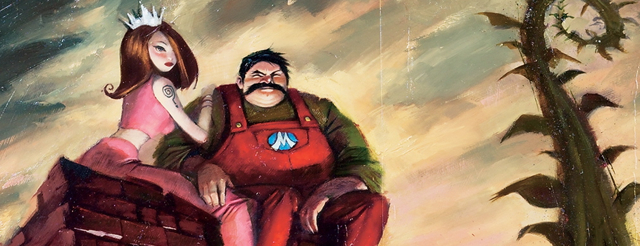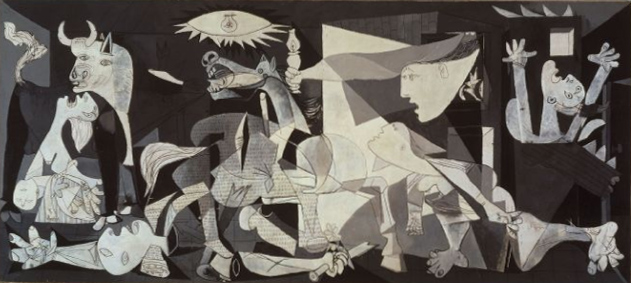
According to Wikipedia (you can already tell this article is going to be amazing, can’t you?) “Art is the process or product of deliberately arranging elements in a way to affect the senses or emotions.” So in everyday language that basically means that if you’ve created something that you want people to interact with in some way, or are in the process of doing this, it must be art. And that really simplifies things for us.
Why? Because this means that every childhood drawing slapped up on your parents’ fridge, every mediocre short story you’ve half-heartedly handed to your English teacher and every painting, picture, sculpture, drawing, photograph, film, book, video game, song, designed object, meal and several types of hand reared broccoli are all art. And it must be true because Wikipedia said so.
The debate of whether video games are art or not has been going on for a fair while now and, to be honest, it baffles me as to why there are so many journalists who claim that video games can’t be considered art. It’s a school of thinking only fueled by a legion of outdated art critics and scholars who are so stuck in the last century that they see Mondrian as the cutting edge of art.
The arts are designed to excite, amuse, intrigue and make us care about the worlds we become involved with. A truly inspiring game has the ability to affect and inspire the player just in the same way that a brilliant drama, poem or painting can.
Of course as soon as we can all agree that games can be interpreted as art, we have to make the distinction between successful games and unsuccessful games. Just as with any other media, some pieces of art are true masterpieces, while others are just over-thought atrocities dedicated to canvas.

So therefore we must analyse games against a set of criteria to see whether they can be rightfully called art or not. Our current standards and areas of scrutiny are likely to be insufficient in assessing the artistic merits of a game due to the fact that an enjoyable game isn’t necessarily an incredibly artistic game. Just look at Pong: it’s hardly the Mona Lisa, is it?
Many immersive, well-designed and thoughtful games would likely fall into the pile of “artistic,” but I think that flawed games are where art and criticism divide. Critics often hound titles that provide more angst than joy, but I think these games could find a new vocation: as art.
Think about it. If you’re ever been to a gallery, chances are that you’ve walked around in mild disinterest, waiting for it to stop raining until you see it. That odd, freakish painting that doesn’t make sense to you, perhaps a chicken painted it? It has an air of pain or passion, but you just walk on because it’s simpler than intellectually wrestling with a piece of canvas.
And now I present to you the frustrating game, our equivalent.
Looking at the bizarre pointlessness of Electroplankton, the brutal difficulty of Super Mario Bros.: The Lost Levels or the utter brain melting anti-logic of the Phoenix Wright series. What can we see other than art? As a child I was given an Earthworm Jim game for the Game Boy Advance but for some reason could never progress further than the second level due to some form of impenetrable barrier. What is more artistic than a game in which you can only play the first level over and over?
These frustrating games generate a powerful reaction from us, even if most of the time that reaction is the urge to smash something. Whether by design or error, frustrating games that pose some form of imposing challenge or stumbling point make us want to do better and overcome this unfair toil, drawing us into their fractured world perfectly. How utterly artistic of them.
A brilliant game can always be seen as art. Immaculately conceived worlds that offer the perfect experience are like a masterpiece from the Old Masters. Those rare jewels shine all the brighter when you compare them with the landslide of mediocre cash-ins and half-hearted experiences that come across more as a blasé landscape of some hills in the English countryside.
And as for those rebel games that delight and disturb in equal amounts? Welcome to the latest form of contentious and evocative modern art.

The works of art featured in this article are The M.K., an i am 8-bit piece by Jose Emroca Flores at the top of the page, a screenshot from the DS and DSiWare game Electroplankton, above to the right, and Pablo Picasso’s Guernica, directly above.




 ShareThis
ShareThis







This. Seriously, it’s such an easy point to make, and yet people don’t make it often enough. Oh, Mr. Ebert, why are you such a big meanie?
I don’t really care if games are considered art or not. I love them and that’s all I care about. What games are NOT though, are films or paintings.
Well…. no. It would be very hard for a game to be a painting, I mean where would you plug in the controller?
Clearly it’d be a Kinect game!
Now that would be one way to make galleries more fun!
Cybernatography: (si-ber-nay-to-graf-ee) 1. The art of performing a process through use of computers. 2. Video games or computer games.
That’s basically what you’re doing when you’re playing a game: you’re performing a process. That it’s meant to be fun is what makes it a game.